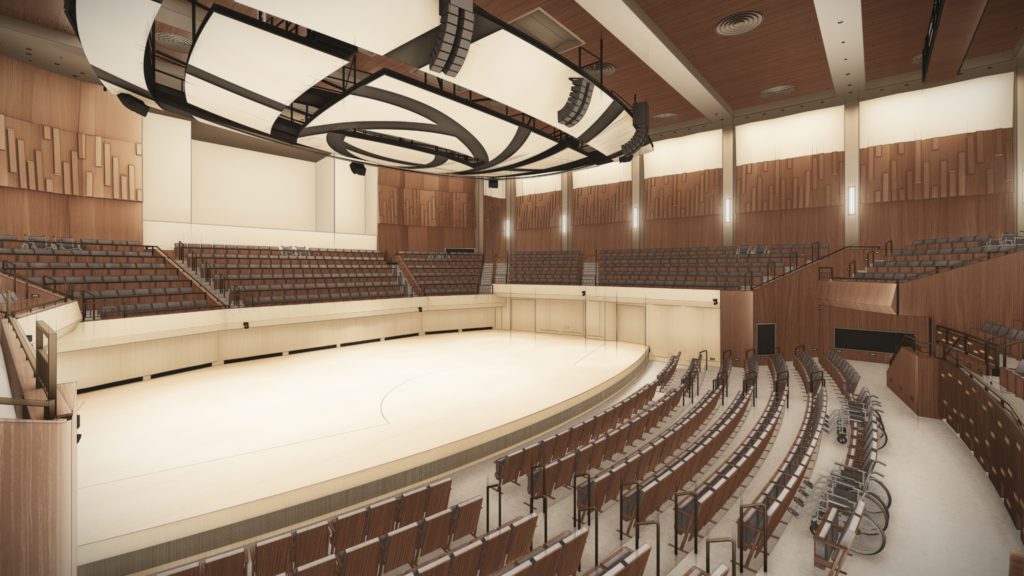
See also Faculty members enthusiastic about BYU School of Music plans
The BYU School of Music will soon have a new home.
Ed Adams, Dean of the BYU College of Fine Arts and Communications, made the announcement Thursday, February 20. Construction is scheduled to begin by late spring 2020 and is expected to be completed by Fall Semester 2022. Big D Construction has been selected as the general contractor for the project with design by HKS Architects.
The 170,000 square-foot building will be located in the southwest corner of the parking lot east of the J. Reuben Clark Law School and will feature a number of upgrades to the facilities the School of Music currently has in the Harris Fine Arts Center.
Impacts on parking, whether the HFAC will be remodeled or replaced to meet the needs of other programs housed there, what the new music building will be named, and timelines for projects beyond the music building are still evolving. “Today we’re going to celebrate the new space for the School of Music, and then we’re going to start working on what the next thing is after that,” College of Fine Arts and Communications Dean Ed Adams said.
Plans for replacement facilities for all or some of the HFAC’s occupants have been in development for years. Adams said inflation pushed the current plan forward. “We had to move on something. The cost of construction in Utah has just skyrocketed.”

The new building’s design followed a process that included talking to students one on one about their experiences, holding focus groups and touring other facilities across the globe. Adams said the main objective was improving students’ experience. “I heard from the vice president that this is the most researched ever to be done at BYU,” Adams said.
He added that the new music building will increase the amount of square-footage the school works with and will fix a number of problems that current music students currently face, such as the lack of a concert hall and a choral room — currently students practice and perform in an auditorium — and rooms that are not fit well acoustically to the point of being a “safety issue.”

“We actually have a situation, where because the sonic volume gets so high in the orchestra and band rooms, that students are required to wear earplugs,” Adams said, adding that the School of Music director compared the situation to “giving painters gloves and sunglasses to do what they do.”
The new music building will feature a 1,000-seat vineyard-style concert hall, where seating surrounds the stage from all sides. Although the new building’s concert hall will be smaller than the HFAC’s deJong Concert Hall and a 250-seat recital hall, smaller than the current Madsen Recital Hall, Adams said the new hall is a big step up — especially since it will be the only vineyard-style hall between Missouri and California.
The vineyard design will accommodate the school’s various choirs and will allow students to sit toward the back of the stage and observe and learn from observing the performing musicians. The stage will also feature built-in, retractable risers for choirs.
The building will also have a a lobby with social stairs and other seating where students can study and have informal “Concerts at Noon.”
“One of the challenges of the Harris Fine Arts Center is there are no places for students in this building,” Adams said. “We’re hoping to resolve that here with the School of Music in that space.”
He added that the new building will include 10 more practice rooms than are currently available in the HFAC. Unlike the the practice rooms in the HFAC that are below ground, these rooms will be on the upper levels of the building where there is more light and will be closer to faculty offices to better facilitate faculty-to-student mentoring.
“The space for faculty and the practice rooms will be much more beautiful, a lot more light, much more aspirational for the students,” Adams said.
Adams said the new building will be a “good to really-good facility.”

“Is it the best out there? Probably not. And we probably wouldn’t build that type of facility only because we have to respect where our funds and sources come from,” Adams said. “But for our students and faculty in the School of Music, this will be exceptional.”
“What we forget sometimes is music is a performing art; it is the pinnacle experience for them to perform, that’s what they work toward. And so we need to provide spaces that help them get to that point to do what it is that they’re longing to do,” he said.
Adams said transferring the School of Music to its own building will not only be beneficial for the the School of Music but the other faculty and students in the HFAC as well.
“Music is beautiful to hear to musicians, but if I’m in the film program and I’m watching a classic film, the last thing I want to hear is the four tubas come in over across the film. These have been a long standing challenges,” Adams said. “The issue we’ve been pursuing is a new building for music. The reason why is because it does two things: one, it isolates the sound of the music, and two, we can acoustically build it easier now.”

Adams hopes these improvements to BYU’s musical facilities will help take the programs to the next level. He recalled a visit from acoustics specialist Mark Holden who was working on facilities at Juilliard at the time.
“He said, ‘You could possibly be the best in the world if you had good music facilities,'” Adams remembers. “For the first time, I had a sense that President Kimball’s message and prophetic vision for the gospel of arts could come true.”




